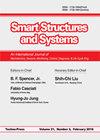Extraction of bridge information based on the double-pass double-vehicle technique
IF 2.1
3区 工程技术
Q2 ENGINEERING, CIVIL
引用次数: 1
Abstract
To identify the bridge information from the response of test vehicles passing on it (also known as the indirect approach) has aroused the interest of many researchers thanks to its economy, easy implementation and less disruption to traffic. The surface roughness of bridge remains an obstacle for such method as it contaminates the vehicle response severely and thereby renders many vehicle-response-based bridge identification methods ineffective. This paper aims to eliminate such effect with the responses of two different test vehicles. The proposed method can estimate the surface profile of a bridge based on the acceleration data of the vehicles running on the bridge successively, and obtain the normalized contact point response, which proves to be relatively immune to surface roughness. The frequencies and mode shapes of bridge can be further extracted from the normalized contact point acceleration with spectral analysis and Hilbert transform. The effectiveness of the proposed method is verified numerically with a three-span continuous bridge. The influence of measurement noise is also examined.基于双通双车技术的桥梁信息提取
从通过桥梁的测试车辆的响应中识别桥梁信息(也称为间接方法)因其经济、容易实现和对交通的干扰小而引起了许多研究者的兴趣。由于桥梁表面粗糙度对车辆响应的影响较大,使得许多基于车辆响应的桥梁识别方法效果不佳。本文旨在通过两种不同试验车辆的响应来消除这种影响。该方法可以根据连续在桥上行驶的车辆的加速度数据估计桥梁的表面轮廓,并获得归一化的接触点响应,证明该方法相对不受表面粗糙度的影响。通过谱分析和希尔伯特变换,可以进一步从归一化接触点加速度中提取桥梁的频率和振型。以一座三跨连续桥为例,验证了该方法的有效性。研究了测量噪声的影响。
本文章由计算机程序翻译,如有差异,请以英文原文为准。
求助全文
约1分钟内获得全文
求助全文
来源期刊

Smart Structures and Systems
工程技术-工程:机械
CiteScore
6.50
自引率
8.60%
发文量
0
审稿时长
9 months
期刊介绍:
An International Journal of Mechatronics, Sensors, Monitoring, Control, Diagnosis, and Management airns at providing a major publication channel for researchers in the general area of smart structures and systems. Typical subjects considered by the journal include:
Sensors/Actuators(Materials/devices/ informatics/networking)
Structural Health Monitoring and Control
Diagnosis/Prognosis
Life Cycle Engineering(planning/design/ maintenance/renewal)
and related areas.
 求助内容:
求助内容: 应助结果提醒方式:
应助结果提醒方式:


